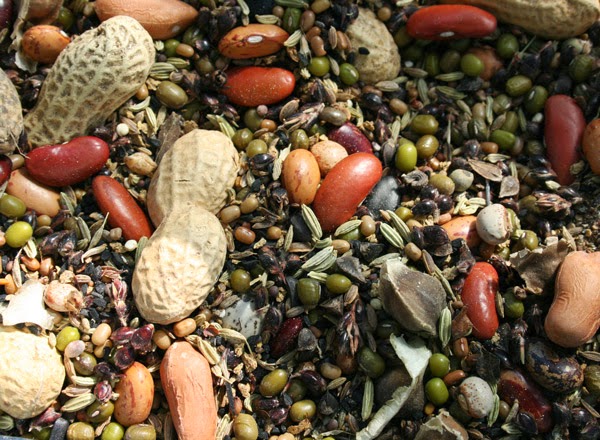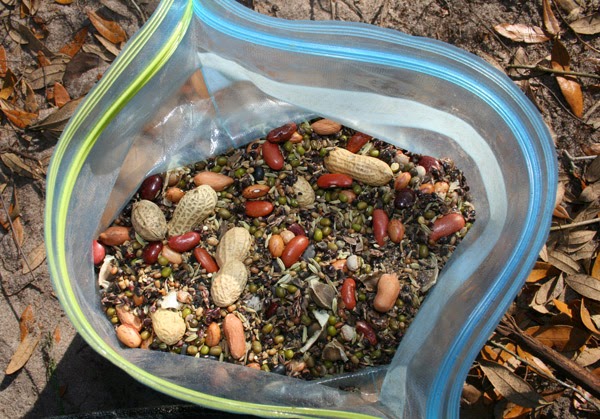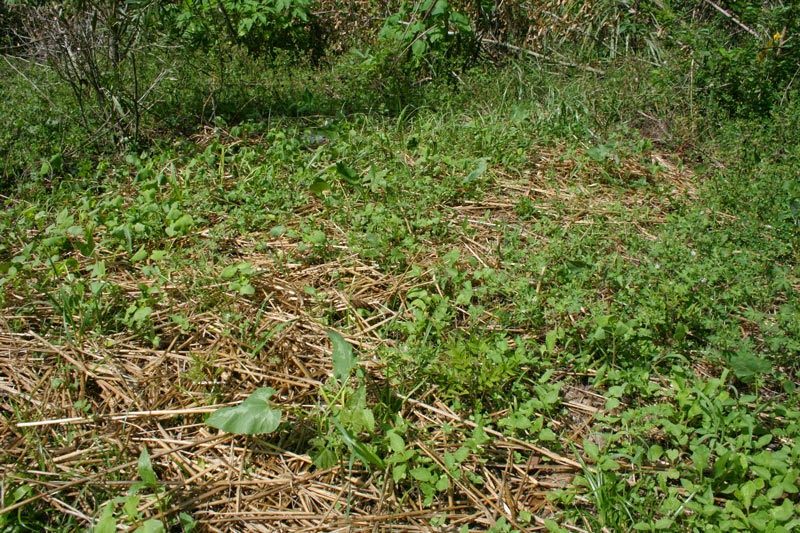Behold my epic cover crop seed mix!
That’s right boys and girls – I mixed roughly 1.5 trillion different types of seed together!
Then I packaged it in my secret patented way:
That bag actually SEALS AT THE TOP, holding in the (Potential) Food Forest Freshness!
I’m a fan of cover crop seed mixes but now I’ve gone all out.
Here’s what I’m doing to add more biomass/food forest plants quickly:
1. Let the chickens tear up a piece of ground for a few days in their tractor
2. Tear up the ground a bit with a broadfork
3. Toss handfuls of seeds
4. Throw down some loose straw
5. Water for a few weeks and watch the magic
So what’s in this cover crop seed mix? There are so many things I’ve forgotten the complete recipe, but I can tell you it includes:
Mung beans
Pinto beans
Pigeon peas
Moringa
Mustard
Buckwheat
Fennel
Dill
Peanuts
Amaranth
Wildflower mix
Moth beans
Black beans
Southern peas
Castor beans
Radish
Leucana
Sorrel
Luffa
Marigolds
Zinnias
Morning glory
Velvet beans
Sorghum
Kebarika beans
Tickseed coreopsis
Cosmos
Asjwan (whatever that is… got it from an Indian market!)
Chia
…and lots more. After a week, lots of stuff starts coming up:
Look at that beautiful mess! Can’t wait to see what madness happens next.
If you have lots of seeds and a sprinkler, you can do this. You’re guaranteed to get something cool.
I keep adding seeds to a big bowl on the counter, then throwing more out on a patch every week or so, then adding more…
Half of these seeds came from bags at the Oriental store or from the bulk bins at the local organic market.
Anarchy at its finest.





20 comments
But is it all edible? How do you identify what you are about to eat? Marigold? Morning glory? Edible?? Don't peas need a trelis?
No, it's not all edible. A lot of them are just there to build the soil and add pollinator insects to the yard. Peas will creep along the ground and still yield some pods. As for identification, you get good at it after a while.
Another trail blazing idea man! Hope to see pics of the major greenery once its going full till!
Walmart carries some ultra-cheap seed packs (like 20¢ each). I'm gonna have to try this.
Cool. Have also seen where people make seed balls and throw them into vacant lots.
Oh heck yeah. There are spots of wildflowers here and there in my county that may or may not have been planted in that very manner via seed balls that may or may not have been chucked out of the window of my van.
You’re a pissa I’m gonna try that
Oh, I love to see this. I started college this year in St. Petersburg and have taken on the challenge of improving a plot of land that the school garden is on. There are already some good-sized, established/producing fruit trees there, but the soil is typical poor quality sand and most of the area is exposed ground with low-growing grass. I’ve been cutting seedheads from local “weeds” and some other sources and scattering them around the area- so far I’ve spread out alba bidens, a smooth-stemmed amaranth, dune sunflower, some marigolds, another large-growing, tough-stemmed weed with leaves that smell and look somewhat like carrot tops, sunn hemp, lemongrass, necklacepod, mimosa, beautyberry, and some others. It will be interesting to see what’s sprouted with the rains when I come back in the fall.
One thing I was surprised at seeing on your list though was castor beans. I didn’t know what these were when I first came to florida, but I noticed the tall, fast-growing plants around the edge of a (brazilian pepper) treeline. They drew me because of how many pollinating insects I saw around the flowers, and since it seemed like they grew so quickly I thought it may be a good candidate for a chop and drop and/or a border, and since it doesn’t grow dense maybe an understory under that as well. But when I heard about its toxicity I started to question its usefulness as that. I know that the beans have much more highly concentrated levels of ricin, but do the plants themselves have any? Is it a type of toxin that might be harmful to surrounding plants, or the microfauna which breaks it down? I may still try to use these, but I also have to take into account that many people who visit this “garden” won’t know how to identify the plants and will be expecting edible food to be grown there. I definitely don’t want any cases of accidental/careless poisoning to come out of it.
Thanks for listening
-Jeremy
I get your feelings on castor. I’d use it as a first stage colonizer of poor soil, since it thrives under marginal conditions, then back away from it later if I were worried about accidental poisonings. I haven’t been able to find any information on its potential toxicity to soil life and it’s such a great producer of biomass I just go for it.
As long you know what it is your good
It’s a plant that comes in handy if the bad guys should show up
Be great on poison arrows
We are right over the Skyway bridge from you Our lot was a totally overgrown Brazilian Pepper forest. Men cleared the land for us, but I still went/go around the property and identify ‘weeds’ with a plant ID app and we had a lot of that Castor Bean. Thanks for the question because I was curious about it being safe as well. As for your propagation of empty lots, that’s awesome
I grew up in the country. All my life we grew large vegetable gardens. My parents, grandparents, aunts, uncles, friends and neighbors. We all canned and preserved baked from scratch. No one did without you simply traded for what you were lacking. After recently relocating to a city where my garden space was a twenty by four strip behind my apartment I realized I can do something to help not only myself but the neighborhood.
There are quite a lot of hungry and homeless here. Id like to figure out a way to get the city to allow spaces throughout our area for community gardening. The local parks businesses and schools have abundant unused spaces. For the children learning to grow their own food would be a wonderful useful lesson. Plus helping our local shelters and pantrys and community.
If anyone can help me figure out how or where to get seeds donated or plants? What agencies should I contact or are there grants I can apply for? I already have a plan written up for my idea. Ive never done something like this but feel very passionate that I need to follow through. Any ideas comments or thiughs are welcome. Thanks angkla76@aol.com
I would first find local gardening groups on MeetUp.com and Facebook, then talk with them. See if there are others in your area with similar inclinations and ideas. I would skip the big government agencies altogether and see if there are charities or others that have connections already you can use. City hall might be another option.
[…] For quick ground-covering species I like cassava, Tithonia diversifolia, pigeon peas, black-eyed peas and big crazy seed mixes. […]
[…] giving predator species a good place to live, along with providing food for pollinators. I made big epic seed mixtures and threw them around open patches. Mixes like this: It is good that you’re already […]
[…] giving predator species a good place to live, along with providing food for pollinators. I made big epic seed mixtures and threw them around open patches. Mixes like this: It is good that you’re already […]
[…] This isn’t the first cover crops mix I’ve made. Some years ago I made a much crazier mix: […]
Some kasuri methi (fennugreek) might be good in there! Nice ground cover, tasty herb, seeds are a good spice, and livestock enjoys it too!
Would this be good for chickens? Ours free range and they are awesome, they walk around the perimeter of our 5 acres every sun up and evening. But I want to give them their own garden area where they can forage and relax, knowing they’re gonna make a mess of it I’m a newer chicken owner and I haven’t checked to see if you have any videos on it, but I’m guessing this might be good for them, too
Yes, but they really will chew it all up fast.
Comments are closed.